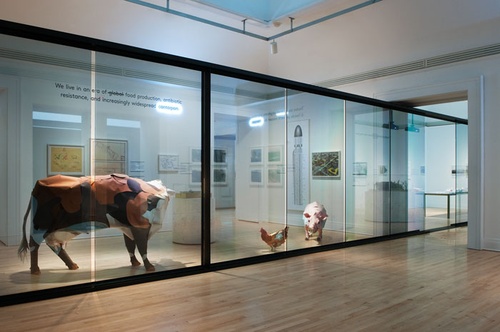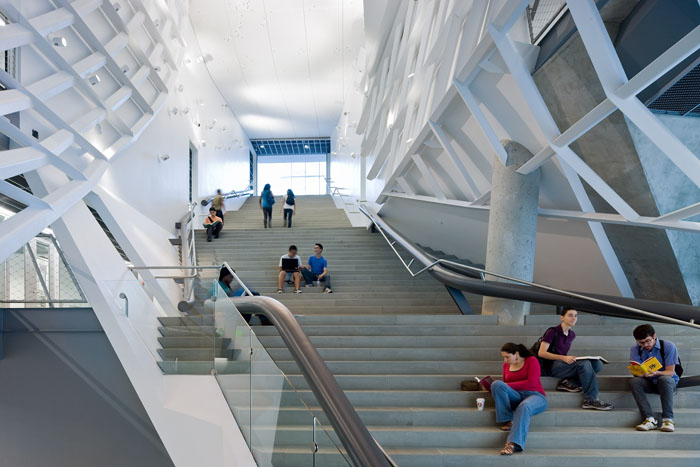
New Remedies: Imperfect Health at the CCA
Architects play doctor in an exhibit about illness and the built environment.
A view of the CCA exhibition Imperfect Health, including paper "flu" animals by Andy Byers.
Modernist architects once believed good design could cure all of society's ills. Today's architects have learned their limits: they may not be able to design away health concerns, but they can hope to be part of the solutions. The Canadian Centre for Architecture's sleek new exhibit, Imperfect Health: The Medicalization of Architecture, demonstrates how architects, urban planners and landscape architects are handling human health now—and how they have failed to do so in the past.
The Montreal exhibition is framed by the prominence of health topics in news and popular culture: bulletin boards display recent newspaper features about obesity, allergy medication ads and disease-outbreak statistics. In one room, a toy figure of the plump spaceship captain from the 2008 movie WALL-E is propped on a marble pedestal. In response to these markers, Imperfect Health presents a philosophy in which the human body and its well-being become the focal point of design, and contrasts past and present ideas of what constitutes a "healthier" city.
Our easier, more comfortable lives have come at a cost—specifically, higher incidences of asthma, allergies and obesity. As devices such as the elevator have changed from innovations to symbols of inactivity, contemporary architecture is faced with challenges posed by industrialization's so-called solutions. Similarly, the mis- and overuse of certain tree species is thought to be among the causes of the increasing incidence of allergies. In the exhibition, a wall of framed sketches from Cesare Leonardi's 1982 book, The Architecture of Trees, showcases many striking varieties now thought to be health hazards.

A staircase at Cooper Union, NYC, designed by Morphosis Architects.
Imperfect Health includes projects designed to remedy these specific health problems, such as the Italian landscape project Milano Allergy Free, which strives to eradicate any plant that's also a common allergen from Milan's public spaces. Morphosis Architects' Cooper Union building in New York City entices the out-of-shape to start taking the stairs again by making the steps a place for socializing.
However, the move toward "placebo architecture" is the most drastic attitude shift discussed here. The CCA's show includes plans from Rem Koolhaas and OMA's design for Maggie's Cancer Caring Centre in Glasgow, one of several Maggie's Centres across the UK designed by big-name architects. The centres architects'—who also include Frank Gehry and Zaha Hadid—recognized that comfort is really all a building can offer cancer sufferers, and responded to the needs and lifestyles of cancer patients by foregoing traditional sterile hospital environments.
Imperfect Health is open about the ambiguous returns of the projects it showcases. Health concerns have no easy architectural answers; the sometimes-conflicting solutions shown are only early experiments in what deserves to be a widespread exploration. The exhibit's installation, by Brussels architectural firm OFFICE Kersten Geers David Van Severen, perfectly reflects the topic's unresolved nature: the six rooms of the CCA's main gallery space have been divided by mirrored glass walls, highlighting the interplay between different subjects and proposed solutions. Framed photos of green parks and blue glaciers add eye-catching pops of colour. The effect created by the overlapping reflective walls is simple but fantastic; they make the experience of navigating the exhibition captivating.

Body metrics at the CCA.
However, it could be argued that the exhibition is too serene to do justice to the scariness of critical health problems. Words like "obesity" are highlighted on wall text, but the curators have shied away from anything too grotesque or alarming. Andy Byers' life-sized paper pigs, a symbol of swine flu, are beautifully crafted, but only their accompanying wall text evokes the pandemonium of the disease. Even dust samples are displayed with sleek polish, in magnified close-ups that make them look more like art than nuisance. These play off French architect François Roche's Dusty Relief, a building proposal for a contemporary art museum covered in electrically charged wire that would pull city dirt and dust onto its sculpted facade. The CCA is known for its minimal aesthetic, but here its curators have made ill health seem too clean, too attractive. It's easy to get lost in the beauty of the presentation and lose sight of the problems driving the projects on display.
Imperfect Health's captivating examples of the effects of architecture on human health give a well-edited preview of analysis bound to emerge, as architects and planners continue to engage with health issues. The show allows architecture to lead by example, without making viewers too uncomfortable—even when they should be.
Imperfect Health: The Medicalization of Architecture is on display at the Canadian Centre for Architecture (1920 Baile St.) in Montreal until April 1.
Subscribe to Maisonneuve today.
Related on maisonneuve.org:
—Negotiating Negative Peace: The Good Cause at the CCA
—The Architecture of War at the CCA
—Visions of the Future: Modernism in Miniature at the CCA





